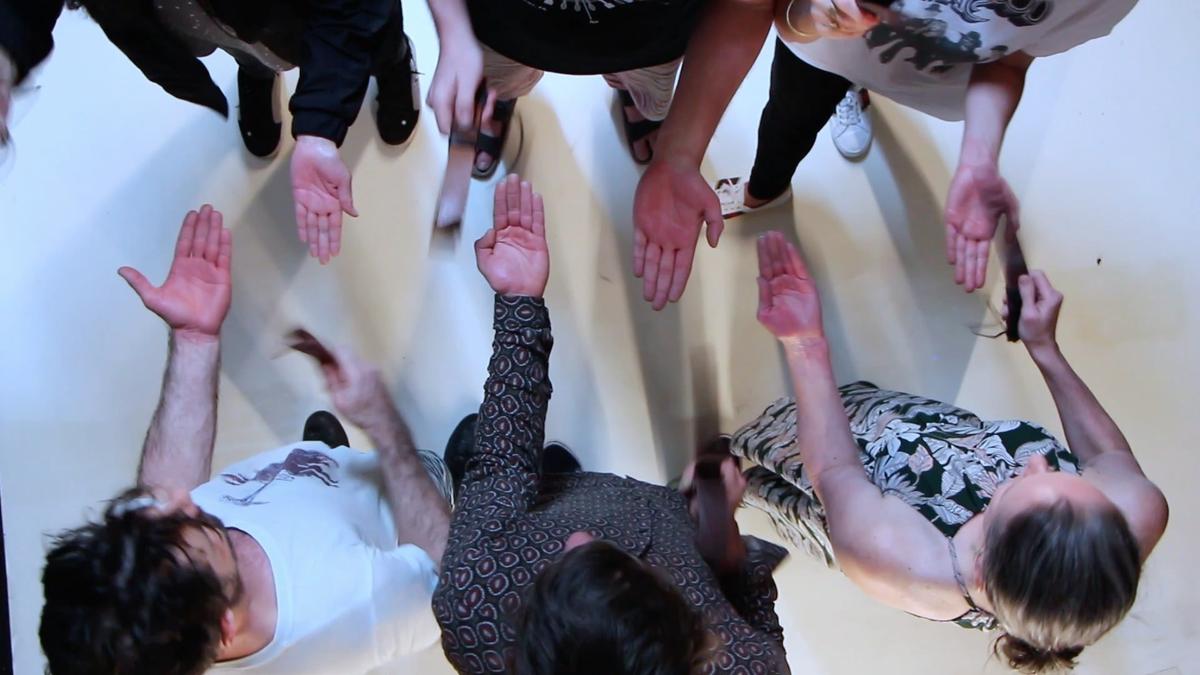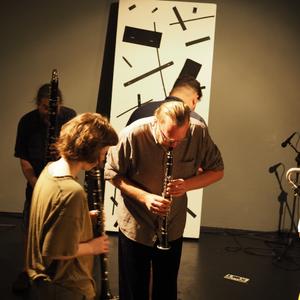The Strap is a series of nine videos created by Auckland-based musician Jeff Henderson. Originally presented at The Audio Foundation in 2019, The Strap was part of a larger installation featuring graphic scores, sculpture and new musical instruments.
In the tradition of Arte Povera, each of Henderson’s works were made from discarded metal and leather offcuts retrieved from the skip bin of Parisian Ties and Belts, a factory working above the Audio Foundation, where Henderson also works. The Strap features groups of performers using Henderson’s leather ‘clackers’—an invented instrument in which different lengths of belt are tied together—as rhythm makers.
In this conversation with artist Judy Darragh, Henderson discusses the musical ideas in the exhibition, making art from junk, and the link between Aotearoa’s history of corporal punishment and the nine videos that comprise The Strap.
The interview includes video, and installation shots from the original exhibition.
Judy Darragh: So the work's called The Strap?
Jeff Henderson: Yes. Well, the exhibition had two rooms. One room was The Strap, and that was all graphic scores, instruments and videos utilising leather. There were a lot of the other works, but they were about using various leather shapes or cuts and translating them into graphic scores. People were invited to either play them on their own or play a little game. I'm mostly dealing with improvised music, and like anything it can settle into really known familiar patterns. And so (the question is) how to upset those patterns and find ways and strategies to keep it surprising for yourself.
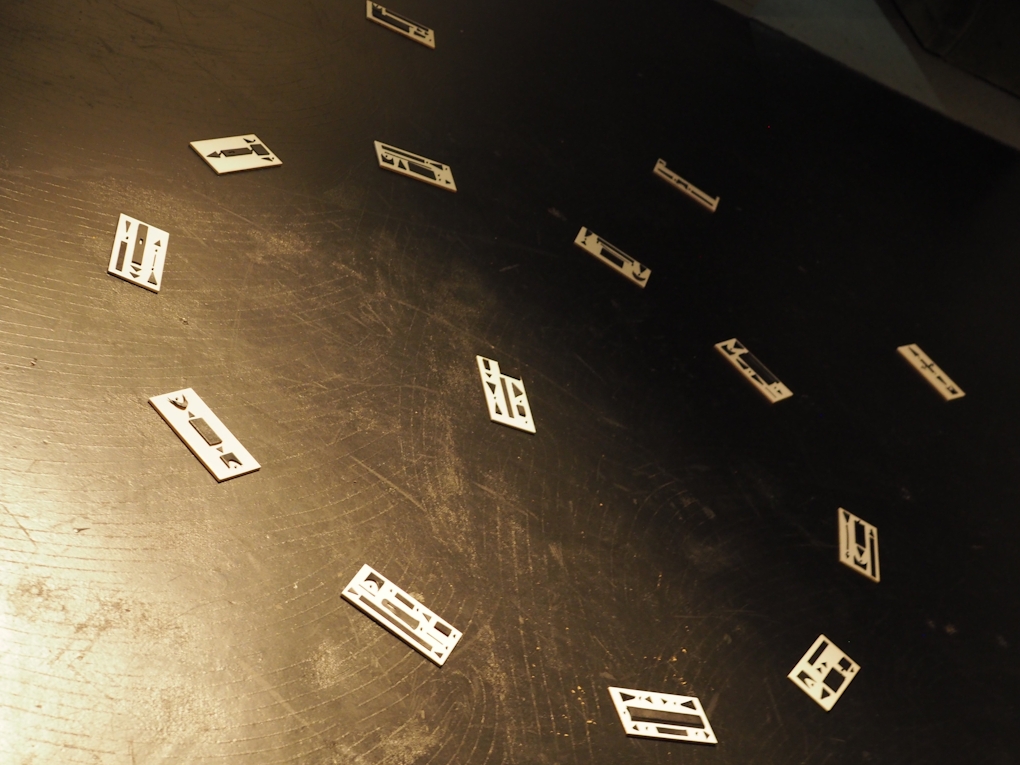
Installation Shot: Jeff Henderson, The Strap (2019) The Audio Foundation, Auckland (2019)
Jeff Henderson: The other room was called Lite Metal. And that was large playable installations of small metallic objects—
Judy Darragh: Belts and buckles?
Jeff Henderson: Yeah. Or just machinery and things.
Judy Darragh: Oh nice. It relates to the activity and the history of the building.
Jeff Henderson: Yeah. And constantly hearing the machines and smelling the leather.
Judy Darragh: That's the first thing that hit me when I came back.
Jeff Henderson: You always know when the Parisian Tie and Belt Factory are making belts because you can smell it. And every time they make belts they throw out all these amazing leather offcuts of different lengths, widths, and consistencies. I’ve been using them for years for different things like handles for bags or hair for masks. Then I thought, "What can I make in terms of sound-making instruments?" So I made about 100, binding different lengths of belt cut offs together so they became clackers.
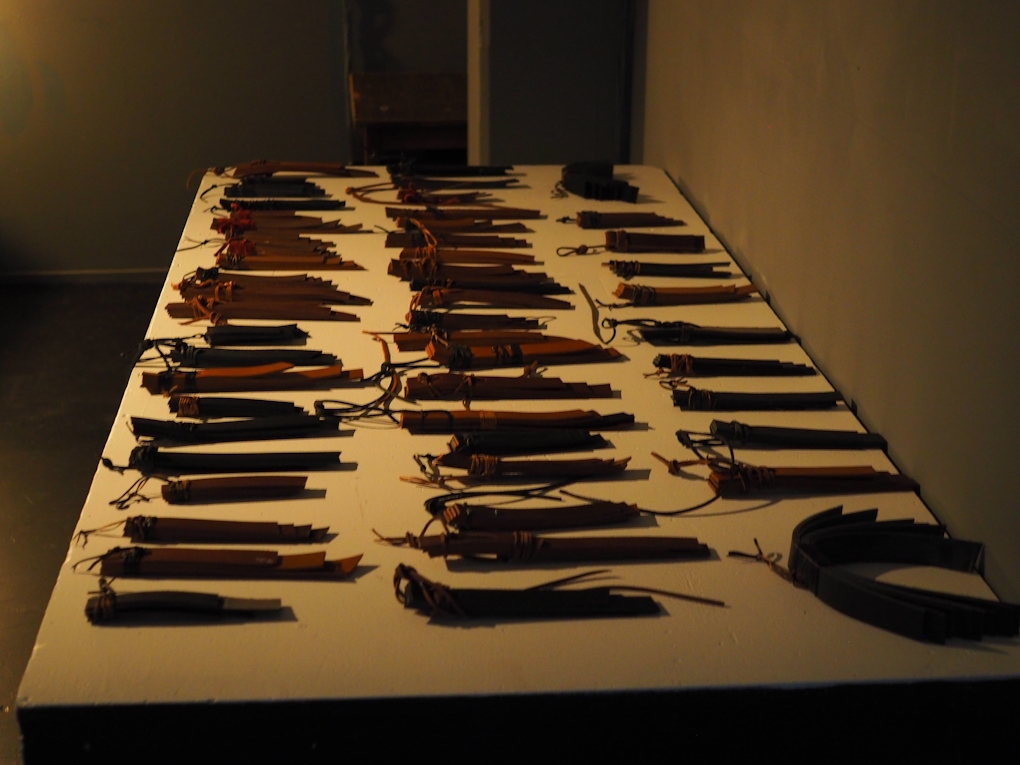
Installation Shot: Jeff Henderson, The Strap (2019) The Audio Foundation, Auckland
Judy Darragh: How do you bind them?
Jeff Henderson: I would punch a couple of holes in each piece and then thread other pieces of leather around them, bind them and tie them off. I worked on them a bit to make them sound good.
Judy Darragh: Do they all have a different sound? Depending on the thickness and the length?
Jeff Henderson: Yeah, and the number of strips, and the way they all hit each other. They sound somewhat different to each other, but not drastically.
Judy Darragh: I guess, because it's leather, which was once on an animal, a living thing, it is very much like... they sound like they're alive. They sound like hands clapping in some ways, skin on skin, rather than metal or a piece of wood.
Jeff Henderson: Totally. I don't know if many instruments —I call them instruments —have been made out of leather.
Judy Darragh: I guess drum skins...but it's still connected to the skin. Like an animal skin.
Jeff Henderson: And it's about a resonator. Whereas these are a bit more like a shaker or even the rhythms of poi. But you don't have a huge number of possibilities with how you can play them.
The Strap 8 (2019) Jeff Henderson
Judy Darragh: So watching those videos, it was quite ouch. I was really feeling the pain as these people were pulling their hands away. Did you still have the strap at school when you were a kid?
Jeff Henderson: Yes. I think it stopped around 1991, when it became illegal. A lot of schools had phased out corporal punishment before then. But the one I went to was one of the last.
Judy Darragh: Did you get the strap?
Jeff Henderson: Yeah. The strap was more of a primary school thing. And the cane at high school.
Judy Darragh: Being an old school teacher, I don't think I ever sent a kid to get the strap. I hope I didn't. But I do remember the Deans would stand in the hall with their big canes. It was really intimidating. Kids would go past and they'd sort of tap them. And then kids at primary school coming back from having the strap and they're trying not to cry and they're sort of brutalised...
Jeff Henderson: I had a teacher, he would take 12 boys out to cane them one by one. And you had to put your head between your legs and look him in the eye as he took a six-foot run up. And you’d try not to cry or let it affect you. You didn't tell anybody. Certainly not your parents or anything like that.
There was one teacher who was an ex New Zealand cricket player and he was the most feared because he was a golfer and he had the best technique. (But) for me it was pretty light compared to others. I spoke to my father and he was like, "Oh yeah, I had 36 lashes when I was in high school". Not all in one sitting, but in total.
And there's so many stories that came out not just about physical abuse, but sexual abuse of children within schools. I wouldn't even say it was a secret that this stuff was happening. We had this one teacher, his nickname said it all, and everyone knew, and the teachers knew what he was up to. And I think only two years ago he was imprisoned for it.
Interviewer: Amazing.
Jeff Henderson: But it also meant that within the culture of the school, things like bullying and violence were very ingrained within the students as well.
Interviewer: Yeah. Fights, big fights in the playgrounds. I remember I got the ruler around the legs. That was a fair whack. That's as close as I got to it, cause girls didn't get the strap.
Jeff: I don’t think so.
Judy: For me, in terms of my generation, it did bring up that whole idea of what was happening in schools. Whereas a lot of the (Audio Foundation) audience probably wouldn't have experienced that.
Jeff Henderson: No, it's very foreign to them. Yeah. Well, obviously there's still violence in homes and schools. But a lot of people I've spoken to are very surprised that it was so much a part of the culture of primary school. Not just the strap or the cane, but aggression and violence.
Judy Darragh: I think the fact (the instruments) were a belt is really important. Because you used to get the belt, you'd be threatened with the belt from your Dad or something. (But) there's a lightness in your work too. It was like a playground dare to put your hand out. And then one (participant) wouldn't.
Jeff Henderson: Local artist John Radford. Yes. He broke the rules. It was proposed as a little musical game, but it does involve pain. I guess it's one of those things where you kind of get used to it and then start playing with how far you can go. But you can stop at any time, and you don't have to hit hard. And that's also about the relationship with the other person and your willingness to inflict pain.
There was one couple who did it, Stephen and Marija. And their one was particularly musical. They did things like rubbing, it wasn't all about hitting. Those ones are quite interesting because they were thinking musically.
The Strap 3 (2019) Jeff Henderson
Judy Darragh: Did the rhythms just form as you went?
Jeff Henderson: Yeah. It’s reasonably difficult to maintain a constant (rhythm) because they all have four or five strips that are flapping against each other.
Judy Darragh: I like the POV (point of view). It was sufficiently removed, like...
Jeff Henderson: You don't get to see people's faces so much.
Judy Darragh: Just the odd flinch or rolling back...
Jeff Henderson: Well, that was to draw out the music more than it being performance art. It was more about the creation of the sound on the hands.
Judy Darragh: The lengths were around three to four minutes. That felt like the limit.
Jeff Henderson: Well, that was up to the performers. There was no limit put on anybody. Aaron and Laura were determined to really push each other. That was about eight minutes.
Judy Darragh: Have you thought about what could be extended?
Jeff Henderson: Well, the opening night was quite fun. I asked everybody in the room to form a big circle. We had about 30 people. You got one hand out and then you hit the next (person), going around in a circle. Then you'd reconfigure. You weren't always being hit or hitting the same person. As a live performance piece, it creates an energy in the room. It's quite unusual in any kind of music to have physical contact with somebody else.
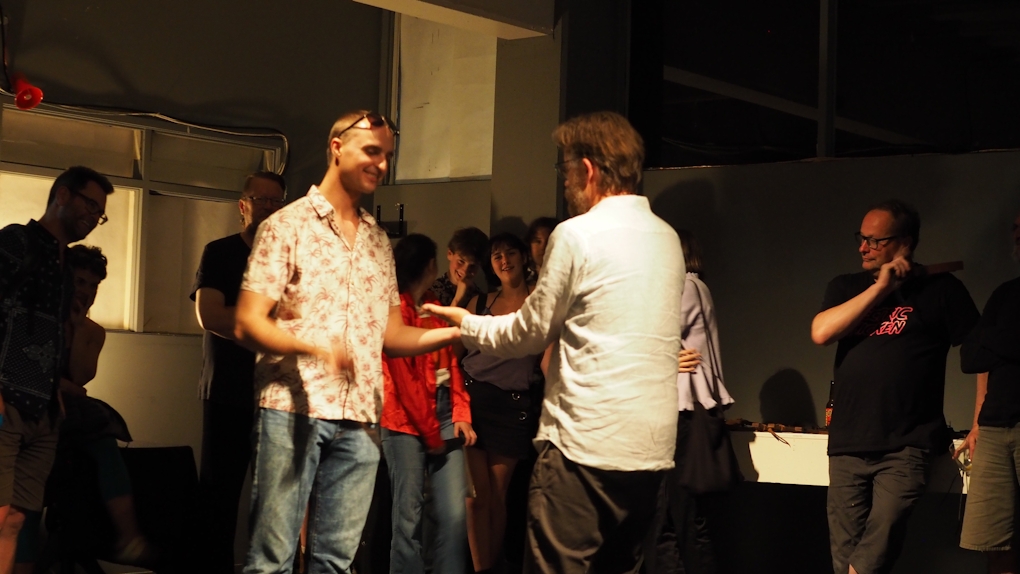
Installation Shot: Jeff Henderson, The Strap (2019) The Audio Foundation, Auckland (2019)
Judy Darragh: Tracey Moffatt did that work, The Slap, have you ever seen it? All of these images of people who have their faces slapped and she cut them all together.
Jeff Henderson: Didn't Abramovich do one with her partner? There was slapping each other's faces turn by turn and it was a durational kind of thing. But that was another thing that I really wanted to...
Judy Darragh: Avoid.
Jeff Henderson: Well, I didn't put any big rules on anything, but it certainly wasn't intended as some kind of durational thing. I liked how some of them had lightness and didn't go too far.
Judy Darragh: So you were basically using the found object, you didn't recut them or anything?
Jeff Henderson: Mostly it was just there. There's so many little shapes and things...
Judy Darragh: Well, it's treasure, eh? And it's that whole surrealist idea of finding something that you can then use...
Jeff Henderson: Totally. For years I’ve done projects where I've made instruments (from) things like rubbish. Especially if I'm traveling. I like it because you don't know what's going to happen at the end.
Judy Darragh: Also it's just lighter on the planet. And you're not beholden by this object or form having to last forever. Especially in the art world, there's this archival thing. I like that something just lasts for that moment. You find it by chance, you use it. It's ephemeral.
Jeff Henderson: It can go back to being junk at any point.
Judy Darragh: It's done its thing. Yeah. I source a lot from secondhand shops, and then after a show I usually unroll everything or break it up and take it back. I'm just interrupting the natural flow of it, and then putting it back in.
Jeff Henderson: Yeah. (This project) wouldn't have come about in any other way. It's really from walking past a rubbish bin once or twice a week and taking things out of it that are useful or that I like.
Judy Darragh: And contemplating.
Jeff Henderson: Yeah. Keeping them for sometime where suddenly you just go ‘Now I've got the idea’.
Judy Darragh: Yeah. I love those moments.
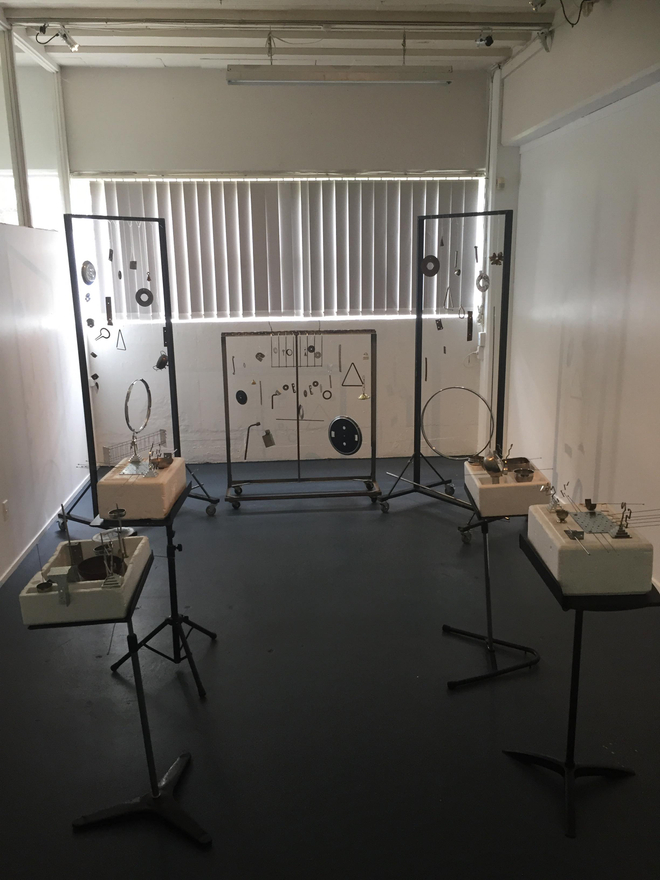
Installation Shot: Jeff Henderson, Lite Metal (2019), The Audio Foundation
